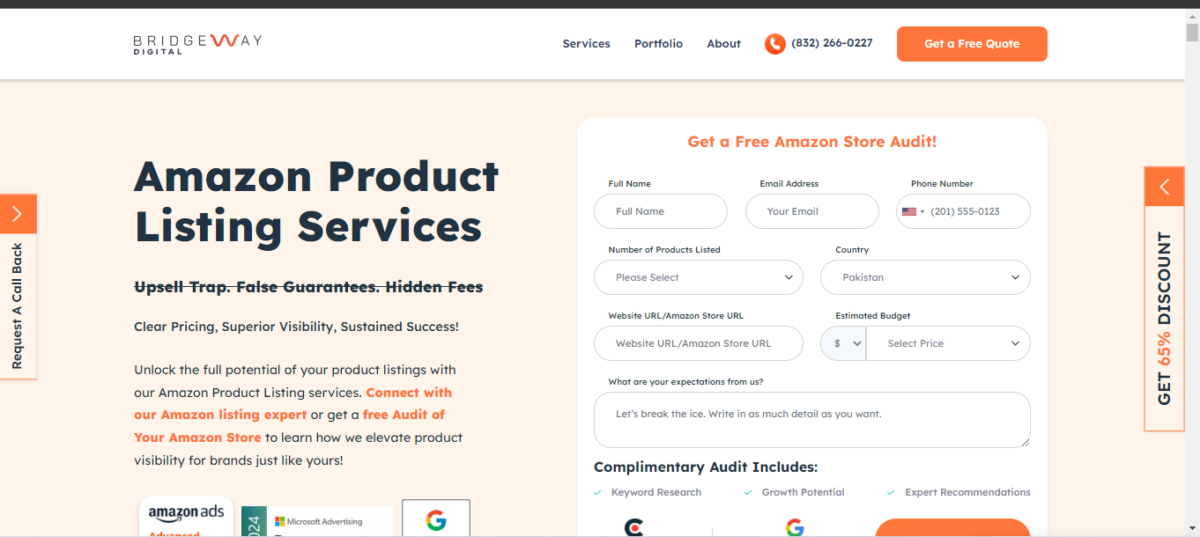Top Secrets for Amazon Listing Optimization

Amazon is a highly competitive marketplace, and standing out among millions of products requires more than just creating a listing. The key to success lies in Amazon Product Listing Services, which can significantly impact your product’s visibility, search ranking, and conversion rate. Whether you’re a new seller or a seasoned one, unlocking the secrets to optimizing your listings can help you achieve higher sales and greater success on Amazon. Here are the top secrets for Amazon listing optimization to maximize your product’s potential.
1. Strategic Keyword Integration
Keywords are the backbone of your Amazon listing’s search visibility. Amazon’s A9 algorithm matches product listings with customer searches based on the keywords you include. However, it’s not just about stuffing as many keywords as possible; placement and relevance matter too.
- Tip: Start with comprehensive keyword research using tools like Helium 10, Jungle Scout, or Amazon’s own auto-suggest. Identify high-performing primary keywords and long-tail keywords that capture more specific customer intents.
- Optimal Placement:
- Title: Place the most relevant and high-volume keyword near the beginning of your product title.
- Bullet Points: Incorporate secondary keywords naturally into the bullet points to improve visibility without keyword stuffing.
- Backend Search Terms: Use the backend search fields for any relevant keywords that don’t fit organically into your title or description.
2. Craft a Clear, Keyword-Rich Title
Your product title is crucial not only for search rankings but also for customer engagement. An optimized title should clearly describe the product while including the most important keywords.
- Tip: Stick to Amazon’s title guidelines, which generally recommend including key information such as brand name, product type, and essential features (size, color, material, etc.). Avoid keyword stuffing and prioritize readability.
- Example: Instead of “Bluetooth Speaker,” opt for something more specific like “Portable Bluetooth Speaker with 20-Hour Battery Life, Waterproof, Enhanced Bass, Black.”
3. Create Persuasive and Concise Bullet Points
Bullet points are where you highlight your product’s key features and benefits. This is a prime area to convey important information while keeping your content scannable for potential buyers.
- Tip: Focus on both features and the customer benefits they provide. For instance, “Lightweight design” can be expanded to “Lightweight design for easy portability during travel or outdoor activities.”
- Keyword Integration: Include relevant keywords naturally within each bullet point, but keep the primary focus on readability and conversion.
4. Maximize Product Descriptions with A+ Content
If you are brand-registered on Amazon, using A+ Content (Enhanced Brand Content) is a powerful tool. It allows you to create visually enhanced product descriptions with images, comparison charts, and more. A+ Content can drastically improve customer engagement and conversions.
- Tip: Use A+ Content to provide additional information about your product, explain how it solves customer pain points, and emphasize your brand’s story. Use images and graphics to make the content more visually appealing.
- Bonus: While A+ Content isn’t indexed for keywords directly, it can still enhance conversion rates, which in turn boosts your search rankings.
5. Leverage High-Quality Product Images
Images are one of the most critical aspects of your Amazon listing. High-quality visuals not only improve the look of your listing but also play a key role in conversions. Amazon allows up to nine images per listing, including one main image and eight additional images.
- Tip: Use high-resolution images that clearly show the product from different angles. Include lifestyle images to help customers visualize the product in use.
- Bonus: If available, add a video to demonstrate the product’s functionality or showcase customer testimonials. Video can dramatically improve customer engagement and trust.
6. Include Relevant Backend Search Terms
Amazon provides sellers with a space to input backend search terms, which are not visible to customers but play a key role in search ranking. These terms should be used to capture additional keywords that didn’t fit naturally into your listing’s title or description.
- Tip: Use the backend search fields to include alternative keywords, common misspellings, and synonyms. Avoid duplicating keywords from your title and description.
- Limit: Stick to Amazon’s 250-byte limit for backend search terms. Focus on keyword variety rather than repetition.
7. Boost Your Reviews and Ratings
Positive reviews are crucial for building trust and increasing your conversion rate. The more reviews you have, especially with higher ratings, the more likely customers are to purchase your product.
- Tip: Encourage satisfied customers to leave reviews by using Amazon’s “Request a Review” button. Consider enrolling your product in Amazon’s Early Reviewer Program or Vine Program to gather reviews for new products.
- Address Negative Reviews: Always respond to negative reviews professionally and offer solutions to improve customer satisfaction. Showing active customer service builds trust with future buyers.
8. Utilize Amazon’s A/B Testing for Listings
Amazon offers an A/B testing tool through “Manage Your Experiments” that allows brand-registered sellers to test different versions of their product titles, images, and A+ Content. This helps you determine which version performs better in terms of conversion and click-through rates.
- Tip: Run experiments for a minimum of two weeks to gather meaningful data. Test one variable at a time, such as testing different images or headlines to understand which has the biggest impact.
9. Monitor and Adjust Pricing Regularly
Pricing plays a huge role in conversion rates. Amazon is highly price-sensitive, and customers often compare prices between products before making a purchase. Regularly monitor your competitors’ pricing and adjust your strategy accordingly.
- Tip: Consider running time-limited discounts or promotions to boost sales. Amazon’s algorithm often rewards higher sales velocity with better search rankings.
- Bonus: Use Amazon’s automated repricing tools to keep your product competitively priced without manually adjusting it constantly.
10. Run Amazon PPC Campaigns
Amazon’s Pay-Per-Click (PPC) advertising can drive more traffic to your product listing. PPC helps boost visibility, especially when launching a new product or if your product is in a highly competitive category.
- Tip: Run both automatic and manual PPC campaigns. Automatic campaigns will help you discover new keywords, while manual campaigns allow you to target high-converting keywords more effectively.
- Bonus: Continuously monitor and optimize your campaigns to improve your return on ad spend (ROAS). Use Amazon’s search term reports to identify which keywords drive the most conversions and adjust your bids accordingly.
11. Optimize for Mobile
Over 50% of Amazon shoppers use mobile devices to browse and buy products. Ensuring that your listing is optimized for mobile users is essential for maximizing conversions.
- Tip: Keep product titles, bullet points, and descriptions concise, as long text can be overwhelming on mobile. Ensure that your images load quickly and are clear on small screens.
- Bonus: Use lifestyle images and infographics to convey important information visually, which is more mobile-friendly.
12. Monitor Competitors and Stay Ahead
Your competitors are constantly updating their listings, so it’s essential to monitor what’s working for them and make improvements to stay ahead.
- Tip: Regularly review your competitors’ listings, keywords, reviews, and A+ Content. Look for trends and opportunities to differentiate your product.
- Bonus: Use tools like Helium 10 or Jungle Scout to track competitor keyword rankings and product performance.
Conclusion
Amazon listing optimization requires a mix of strategic keyword placement, compelling content, high-quality visuals, and ongoing adjustments based on data and performance. By leveraging advanced tools like A/B testing, PPC campaigns, and backend search terms, you can boost your listing’s visibility and drive more sales. Keep refining your strategy, monitoring competitor trends, and making data-driven improvements to stay ahead in the highly competitive Amazon marketplace.
BridgewayDigital: Elevate your digital strategy and Amazon presence with our services. Guaranteed 3x returns. Start with a free proposal now!








